Barsac, Gironde, Nouvelle-Aquitaine 作者: 来源: 发布时间:2021-04-06
I. Population and Area
Total Area: 14,48 km2 (5.59sq mi)
Population in 2017: 2 063
Population Density: 142/km2 (369/sq mi)
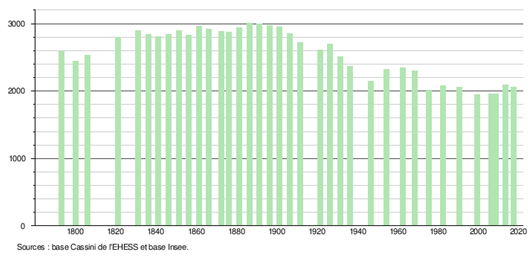
Histogram of demographic change
II. Natural Geography (environment and resources)

Barsac (Barçac en gascon) is a commune in south-western France, located in the Gironde department, in the Nouvelle-Aquitaine region.Its inhabitants are called the Barsacais.
Located on the left bank of the Garonne and crossed by the Ciron, the town is 27 km southeast of Bordeaux, capital of the department, 8.5 km northwest of Langon, capital of arrondissement and 6 km south-east of Podensac, capital of the canton.
The neighboring municipalities are Cérons to the northwest, Illats to the west, Pujols-sur-Ciron to the southwest, Preignac to the southeast; on the right bank of the Garonne, are Loupiac to the east and Cadillac to the north for about one km.
The main road communication route is the departmental road D 1113, former RN 113 (Bordeaux-Marseille), which leads north-east to Cérons and Podensac and beyond to Bordeaux and south-west to Preignac and beyond in Langon. Two departmental roads start from this D 1113 and both lead to the south-west, the D 118 towards Illats and Landiras and the D 114 towards Pujols-sur-Ciron.
Access to the nearest A62 motorway (Bordeaux-Toulouse) is No. 2 in Podensac, 6 km west-southwest.
Access 1 from Bazas to the A65 motorway (Langon-Pau) is 22 km south.
The town has a SNCF station on the Bordeaux-Sète line of TER Aquitaine.
III. ECONOMY
Employment income (%): 78.1 (2016)
Poverty rate by age group of the tax advisor(%): 12 (2017)
Average employment income (€):2 267 net per month (27 200 net per year)(2014)
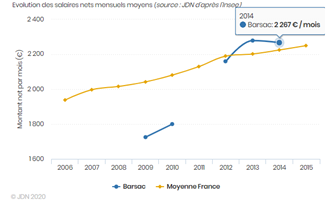
Evolution of average monthly net wages
Sources : http://www.journaldunet.com/business/salaire/barsac/ville-33030
https://insee.fr/fr/statistiques/2011101?geo=COM-33030#tableau-REV_G1
IV. Industrial Characterisitics
Viticulture: barsac, sauternes (vignoble de Sauternes), tombes :
Barsac is a French sweet wine with a controlled designation of origin produced in Sauternes, one of the subdivisions of the Bordeaux vineyard.
The appellation's production area is made up exclusively of the town of Barsac, located near Sauternes, on the left bank of the Cironriver. Classified AOC by the decree of September 11, 1936, the vineyard covers an area of approximately 600 hectares.
1. Vineyard: The Barsac vineyard is set on limestone in Astéries, very largely covered by deposits of alluvium forming terraces with slight slopes. On the banks of the Garonne, some plots are planted on post-Würm alluvium known as "palus clays", but the vineyard begins on the lower terrace (between the D 113 and the railway) dating from the Riss (Middle Pleistocene), with limestone twelve meters below (+12 NGF). On the southern part of Barsac and along the banks of the Ciron, erosion makes limestone outcrop at Astéries and Archiacines locally designated "Saint-Macaire limestone" dating from the Stampien (Upper Oligocene), covered with a thin layer of silt and sand.
It is a clay-limestone soil on which is planted a vineyard of white grapes of the Semillon, Sauvignon and Muscadelle types, used for the production of sweet wines: the producers of Barsac having the right to benefit from the choice of the appellations barsac or sauternes.
1) Harvest: The harvest begins late in the season and can last well after All Saints' Day. The grapes are picked very ripe, until they are affected by the famous noble rot favored by the fogs of the Garonne and Ciron. Sauternes is one of the rare regions in the world which allows the development of this noble rot thanks to the action of Botrytis, thus authorizing the production of naturally sweet wines. It modifies the matter, chemically, aromatically. The skin of overripe berries then becomes purplish and their pulp turns into golden jam. Barsac is a sweet wine.
2) Environment: The presence of the Garonne is constant in Barsac. At the confluence of the Ciron is the port of Barsac, a charming place under the shade of ash trees and poplars where people came to dance on Sundays on the cement track of the Gay house to the tunes of musette waltzes. But the Garonne, usually more than two kilometers from the church, is able to get out of bed and flood almost half of the territory of the commune. All this territory gives a different wine from the Graves, the Palus wine transformed by the deposited alluvium.
On the right bank, the Château du Cros overlooks Barsac and further on the Landes forest. Some distance upstream, the steeple of Sainte-Croix-du-Mont, another famous sweet wine vineyard, emerges from the trees, which already herald the slopes of Malagar, the chateau of François Mauriac, towards Verdelais. Downstream, the hills of Montprimblanc, Loupiac and Cadillac beautifully align their rows of vines facing due south.
2. Wine: This wine goes perfectly with foiegras, roasted chicken, Roquefort or simply a few nuts and bread. It should be served fresh (8 ° C), but not hit.
3. Barsac and Sauternes Wine House: wine cellar specialized in Barsac and Sauternes:
Cedric Bourlez
06 38 47 68 78
E-mail: maisondesvinsbarsac@gmail.com
Website: maisondesvinsbarsac.fr
Facebook page: Barsac and Sauternes Wine House
Address: Place de I'Eglise 33720 BARSAC
Maïsiculture en bord de Garonne.
Sources:http://www.barsac.fr/maison-des-vins-de-barsac-et-sauternes/
V. Attractions
1. L'Eglise Saint-Vincent (Saint Vincent Church)
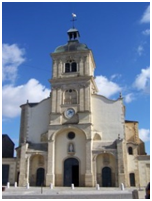
- 33720 Barsac
Phone: 05 56 27 08 03
opening hours: on request
Jewel of 18th century Girondin Religious Architecture.
Built in the 18th century on the site of an old church destroyed in the 16th, the building, dedicated to Saint Vincent patron saint of winegrowers, was classified as a historic monument by decree of December 1, 19081.
Presenting a very sober facade and surmounted by a bell tower with a slate dome, it shelters various pieces of 18th century furniture including a high altar and remarkable and classified altarpieces2, and various artistic works such as Simon's choir paneling, fonts in Quéva marble, organ gallery from Mollié, woodwork from Combes in the sacristy, altarpiece by BarthélemyCabirol.
One of the walls of the interior porch of the church presents a curiosity: about a meter above the ground, a line indicates an exceptional flood of the Garonne with the mention "LE 7 APRIL ANO 1770 DEBORDEMANT"
The Church of Saint Vincent de Barsac has been classified as a historic monument since December 01, 1904.
It has just undergone a complete restoration, both external and internal, supported by the public authorities.
The association "Friends of the Church" works to enhance the interior of the building, animates certain events - see on associative life - and offers guided tours to groups who request it from Michel Derctel .05 56 27 08 03/06 81 34 32 71 or Françoise Mussotte tel. : 05 56 27 34 01
For the history of the church. Websit (for more information): www.vallee-du-ciron.com/barsac/barseglise
Restoration of the Organ: CALL FOR DONATIONS
As part of the restoration of the organ of the Church of Saint Vincent, a call for donations is organized.
You can read the subscription form by clicking on the link opposite: bon-de-souscription-eglise-2016-barsac
Contact: Town Hall 05 56 27 43 00.
2. Port de Barsac (Port of Barsac)
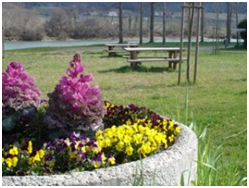
Website for more information: http://www.vallee-du-ciron.com/Documents/Riviere/CiroCanal.htm
Formerly, the Port of Barsac was located behind the current cemetery, but was threatened with silting up and floods were feared.
Intendant Tourny took an order on September 9, 1752 for the formation of a new port at Barsac: the current port. A footbridge was built for the passage of pedestrians, and an access road was built for carts.
The activities of the Port were very important. It was very well built, easy to access. The ebb and flow of the tide is felt up to a height of 8 meters of low water.
The boats moored there easily, they arrived either by tow, or by sail or oar. Navigation took place only during the day because there was no lighting or beaconing. The maximum length of the boats was 29 meters and the draft was 2.20 meters.
All of the Landes wood was floated on the Ciron from Villandraut, hindered by the passage of Moulins. Passelis were built to facilitate these passages. It took all the skill of the rafters to drive these wooden trains to the port of Barsac, where they were stranded and dismantled, before being loaded and leaving by boat for their final destination.
The port is a very picturesque place. It was set up as a promenade with tables, benches, water points and toilets. The port is also a festive place (Saint Jean fires ...).
3. Voiegallo romaine (Gallo Roman Way)
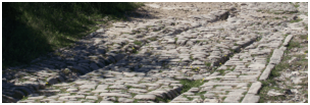
This work uncovered a 226-meter section of Gallo-Roman road, oriented substantially northwest.
Certainly this path had its importance. It came from between the two seas, crossed the Garonne at "Viole", to join the Galienne road at Peyrebidanne, between BARSAC and ILLATS. The visible crossing that remains indicates the direction of the Carolingian construction school bridge, to continue towards the Ciron which was crossed at a place called "La Brousse".
On this path, a bronze fibula dating from 70 years before our era was found.
This road corresponded with another part of the road discovered around MERIGNAC, and it has a branch leading to ILLATS, called the "garden path".
It was, it seems widely used, as shown by the deep ruts of 70 to 80 cm, and occasioned by the passage of carts with wheels encircled by iron. These ruts are arranged in several rows of parallel tracks.
During the excavations of 1974, a trench was made in the track, 1.40 m deep, to allow to see its structure at the base. We were thus able to establish a section of the road.
Immediately to the south of this section of track stretched, a year ago, a small wood, transformed since then into cultivable space, where the Carthusian monastery of La Ronca was located, which would have been built by the Barsacais lords in the 11th century, but of which nothing has remained for a long time.
A Barsacaise association "Archeology" revives these stones from time to time through a cultural event.
Sources :http://www.barsac.fr/eglise-saint-vincent/
http://www.barsac.fr/port-de-barsac/
http://www.barsac.fr/voie-gallo-romaine/
VI. History
Three bronze objects, a dagger with four rivets and another with two rivets as well as a spear point, were collected between 1952 and 1982, in a quarry for extracting clay bricks located along the right bank du Ciron, in a meadow at a place called Tournet. They do not come from the same deposit because their patina is different. The two daggers were probably used as pocket knives. These three objects bear witness to the influences of the Middle Bronze Tumulus civilization in southwestern Germany.
Several archaeological discoveries are attributable to Gallo-Roman or Merovingian antiquity: the town was in fact crossed by the Roman road connecting Bordeaux (Burdigala) and Agen (Aginnum}.
Chief town of the royal provost of Barsac, whose jurisdiction extended in the Middle Ages over a large part of "Gasque land".
For more information on the state of the town in the 18th century, see the work of Jacques Baurein.
During the Revolution, the parish of Saint-Vincent de Barsac formed the town of Barsac.
Between Garonne and ocean, at the gates of Bordeaux and the Landes forest:
Barsac welcomes you all to the heart of one of the most prestigious wine appellations in the World: BARSAC-SAUTERNES.
Barsac, a former royal provost from the 13th century, retains many buildings and monuments built over the centuries that bear witness to its history.
You will thus be able to start your visit with the discovery of the Saint-Vincent church, jewels of 18th century religious architecture and classified as a historic monument in 1908. The richness of the decor and the atmosphere given off by the arched gallery and horns, prowess of balance and harmony, invite you to rest and meditate.
Through roads and paths bordered by low walls, the continuation of your walk will allow you to discover over the landscapes, houses and castles, the oldest of which were built in the 15th century. Perhaps the opportunity to be greeted by a winemaker with whom you can share the passion for the land and the precious nectar.
Barsac, a town proud of its past and its architectural riches, over which time leaves no nostalgia.Barsac, life together. A modern town resolutely looking to the future.
Sources:http://www.barsac.fr/histoire-barsac/
VII. Other information
Personalities linked to the municipality:
1. Marie-Thérèse Charlotte de Lamourous (1754-1836), born in Barsac on November 1, 1754, director of the Mercy of Bordeaux in whose service she founded the congregation of the Sisters of Mercy.
2. Paul Lapeyre (1910-1991), an anarchist activist who retired to Barsac at the end of his life.
3. Tony Frank born Christian Danglade, born in Barsac in August 1946, variety artist with his group of musicians, animated many dancing galas in France in the 1960s and 1970s. Passionate about circus arts and fairgrounds he collects everything that relates to this theme that he exposes in various cultural places, Photographer and columnist in specialized magazines, he works to promote the circus arts through an association law 1901 the "Center for Teaching and Development of Circus Arts ”(CEVAC). In 1981, he was founding president of the École de Cirque de Bordeaux18.
4. Victor de Bastard d'Estang is a French soldier and politician.
Barsac Library
Parc de Montalivet - 33720 Barsac
05 56 27 45 12
The Barsac library opens its doors to you:
Tuesday: 4 p.m. - 6 p.m.
Wednesday: 2:30 p.m. - 6 p.m.
Friday: 4 p.m. - 6 p.m.
The Barsac library is part of the public reading network of the Convergence Garonne Community of Communes
Barsac Library - Parc de Montalivet - 33720 Barsac
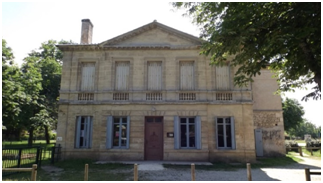
All of the network's libraries are accessible to everyone free of charge. Computerized, they work with a single card which will allow you to borrow and return the works in the library of your choice. They offer many documents on loan (books, periodicals, but also CDs and DVDs), animations throughout the year, as well as online resources and a multimedia space at the Podensac media library.
Find practical information, discover the dates of the next events and consult the network catalog on: mediatheque.convergence-garonne.fr
You can contact the network team from Tuesday to Saturday at 05 56 27 01 58
Sources :http://www.barsac.fr/bibliotheque/
VIII. Contact information
Barsac town hall address :
Mairie de Barsac
23 place Paul-Doumer
33720 Barsac
Opening Hours of the town hall:
Monday to Friday: 8:30 a.m. to 12:00 p.m. and 1:30 p.m. to 5:00 p.m.
Mayor :Philippe Meynard (Mandate : 2014-2020)
Phone number: 05 56 27 43 00
Fax: 05 56 27 43 01
Mail: mairie@barsac.fr
Website :http://www.barsac.fr
Sources :http://www.cartesfrance.fr/carte-france-ville/33030_Barsac.html#mairie
